Spring-Cloud-Gateway源码系列学习
版本 v2.2.6.RELEASE
因为Spring-Cloud-Gateway有大量的Reactor的代码,因此必须得恶补一下Reactor的知识
Flux
一个0-N个元素的异步序列流,可以使用.subscribe来进行订阅,基于发布订阅者模型
类结构
Flux->CorePublisher->Publisher,Flux继承了Publisher,代表它是个是个数据流
range
该方法有两个参数,start和count,表示构建一个start开始到start+count-1的Flux

//源代码方法签名
public static Flux<Integer> range(int start, int count)
//使用例子
public static void rangeTest() {
Flux<Integer> flux = Flux.range(1, 3); // 1->2->3
flux.subscribe(i -> System.out.println(i));
}
//输出
1
2
3
combineLatest
参数为 T为Object[] , R为Flux 的 Function,sources为数据源,例如Flux,当只有一个数据流时,每个元素到来都会执行比较Function,Object[]只有一个数据;多个数据流时,从第一个数据流最后一个元素开始,每来一个元素就会比较一次,Object[]里面有两个数据,分别是第一个数据流最后一个元素和当前数据

//源码方法签名
public static <T, V> Flux<V> combineLatest(Function<Object[], V> combinator, Publisher<? extends T>... sources)
//单数据源使用方法
public static void combineLatestTest() {
Flux<Integer> ints = Flux.range(1, 3);
Flux.combineLatest(o -> {
return (int)o[0] > 2;
}, ints).subscribe(i -> System.out.println(i));
}
//单数据源输出结果
false
false
true
//多数据源使用方法
public static void combineLatestTest() {
Flux<Integer> ints1 = Flux.range(1, 3); // 1->2->3
Flux<Integer> ints2 = Flux.range(4, 3); // 4->5->6
Flux.combineLatest(o -> {
//o[0]:3,o[1]:4
//o[0]:3,o[1]:5
//o[0]:3,o[1]:6
return (int)o[1] > (int)o[0];
}, ints1, ints2).subscribe(i -> System.out.println(i));
}
//多数据源输出结果
true
true
true
concat
合并多个数据源成一个Flux

//源代码方法签名
public static <T> Flux<T> concat(Iterable<? extends Publisher<? extends T>> sources)
//使用例子
public static void concatTest() {
Flux<Integer> ints1 = Flux.range(1, 3); // 1->2->3
Flux<Integer> ints2 = Flux.range(4, 3); // 4->5->6
List<Flux<Integer>> sources = new ArrayList<Flux<Integer>>(){{
add(ints1);
add(ints2);
}};
Flux.concat(sources).subscribe(i -> System.out.println(i)); // 1->2->3->4->5->6
}
create/push(建议跳过,阅读后面的)
适合用于基于自定义的事件触发器,参数是一个Consumer,在consumer里面你将获得一个FluxSink对象,FluxSink有三种事件可供使用next,error和complete,但是create基于多生产者单消费者模型,而push基于单生产者单消费者模型(我也不知道怎么样才是多消费者的代码,测试也发现都是main线程执行)
//源代码方法签名
public static <T> Flux<T> create(Consumer<? super FluxSink<T>> emitter)
//使用例子
Flux<String> bridge = Flux.create(sink -> {
myEventProcessor.register(
new MyEventListener<String>() {
public void onDataChunk(List<String> chunk) {
for(String s : chunk) {
//onDataChunk事件与FluxSink#next事件对应
sink.next(s);
}
}
public void processComplete() {
//processComplete事件与FluxSink#complete事件对应
sink.complete();
}
});
});
defer
延迟加载,参数需要传一个Supplier(无参数,1个返回值),返回值就是数据流,只有订阅了才会去初始化数据源
//源代码方法签名
public static <T> Flux<T> defer(Supplier<? extends Publisher<T>> supplier)
//使用例子
public static void deferTest() {
Flux flux = Flux.defer(() -> {
return Flux.range(1, 3);
});
flux.subscribe(i -> System.out.println(i)); //这一步才会去执行Supplier#get代码
}
empty
创建一个空的流
//源代码方法签名
public static <T> Flux<T> empty()
//使用例子
Flux flux = Flux.empty();
error
传播一个错误
//源代码方法签名
public static <T> Flux<T> error(Throwable error)
//示例代码
public static void errorTest() {
Flux flux = Flux.error(new RuntimeException("exception"));
flux.subscribe(i -> System.out.println(i), error -> System.out.println("Error " + error));
}
just
将多个相同类型的元素转成流
//方法签名
public static <T> Flux<T> just(T... data)
//使用示例
public static void justTest() {
Flux flux = Flux.just(1,2,3);
flux.subscribe(i -> System.out.println(i));
}
merge
将多个流合成一个流,元素的顺序根据流的情况,如下图

//方法签名
public static <I> Flux<I> merge(Publisher<? extends I>... sources)
//使用示例
public static void mergeTest() throws InterruptedException {
Flux<Long> longFlux = Flux.interval(Duration.ofMillis(100)).take(3);
Flux<Long> longFlux2 = Flux.interval(Duration.ofMillis(100)).take(3);
Flux<Long> longFlux3 = Flux.merge(longFlux,longFlux2);
longFlux3.subscribe(l -> System.out.println(Thread.currentThread().getName()+":"+l));
Thread.sleep(1000);
}
//输出
parallel-2:0
parallel-1:0
parallel-2:1
parallel-2:1
parallel-2:2
parallel-1:2
mergeSequential
将多个流合成一个流,元素的顺序根据流的情况根据参数流的顺序,一个流完成才到下一个流
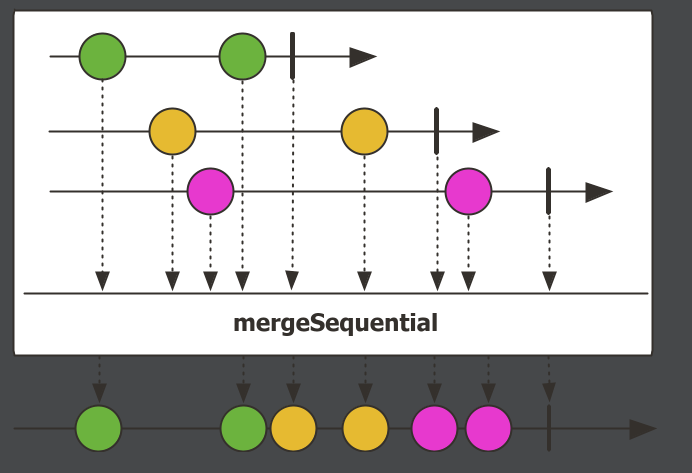
//方法签名
public static <I> Flux<I> mergeSequential(Publisher<? extends I>... sources)
//使用示例
public static void mergeSequentialTest() throws InterruptedException {
Flux<Long> longFlux = Flux.interval(Duration.ofMillis(100)).take(3);
Flux<Long> longFlux2 = Flux.interval(Duration.ofMillis(100)).take(3);
Flux<Long> longFlux3 = Flux.mergeSequential(longFlux,longFlux2);
longFlux3.subscribe(l -> System.out.println(l));
Thread.sleep(1000);
}
//输出
0
1
2
0
1
2
filter
使用Predicate进行过滤
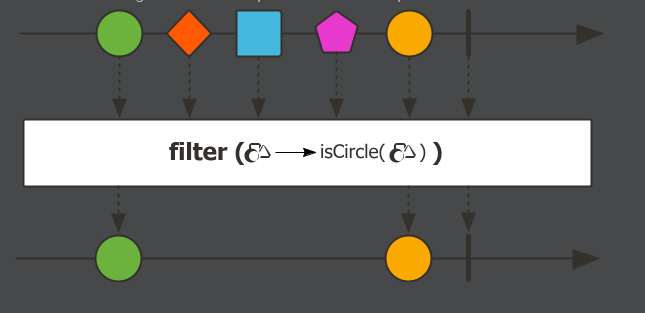
//方法签名
public final Flux<T> filter(Predicate<? super T> p)
//使用示例
public static void filterTest() {
Flux<Integer> flux = Flux.range(1,3)
.filter(new Predicate<Integer>() {
@Override
public boolean test(Integer integer) {
return integer > 2;
}
});
flux.subscribe(i -> System.out.println(i));
}
//输出
3
next
取Flux流的第一个元素(Mono)
//方法签名
public final Mono<T> next()
//使用实例
public static void nextTest() {
Mono<Integer> mono = Flux.range(1, 3).next();
mono.subscribe(i -> System.out.println(i));
}
//输出
1
map
可以对流过的每个元素进行修改
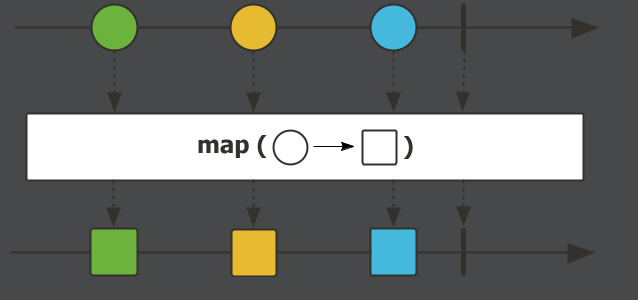
//方法签名
public final <V> Flux<V> map(Function<? super T, ? extends V> mapper)
//使用示例
public static void mapTest() {
Flux<Integer> flux = Flux.range(1, 3)
.map(i -> {
return ++i;
});
flux.subscribe(i -> System.out.println(i));
}
//输出
2
3
4
flatMap
同样可以对元素进行修改,但是flatMap 参数 Function的返回值必须是Publisher,也就是元素变成流
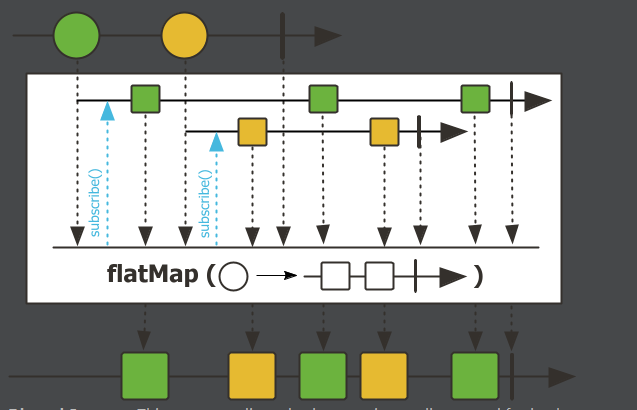
//方法签名
public final <R> Flux<R> flatMap(Function<? super T, ? extends Publisher<? extends R>> mapper)
//使用示例
public static void flatMapTest() throws InterruptedException {
Flux<Long> flux = Flux.range(1, 3)
.flatMap(i -> {
return Flux.interval(Duration.ofMillis(i)).take(3);
});
flux.subscribe(i -> System.out.println(i));
Thread.sleep(1000);
}
//输出
0
1
2
0
0
1
2
1
2
flatMapSequential
可以对元素进行修改,跟flatMap一样,可以将流中的元素转成流,但是flatMapSequential跟原来的流的元素顺序有关
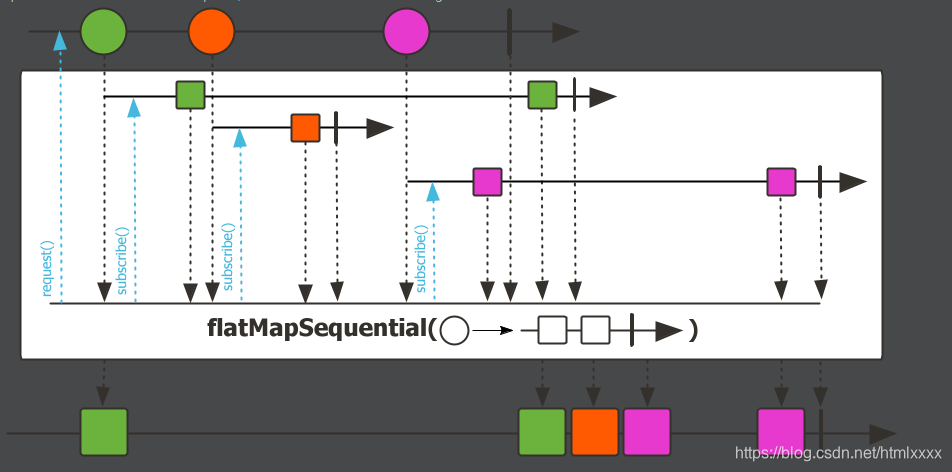
//方法签名
public final <R> Flux<R> flatMapSequential(Function<? super T, ? extends
Publisher<? extends R>> mapper)
//使用示例
public static void flatMapSequentialTest() throws InterruptedException {
Flux<Long> flux = Flux.range(1, 3)
.flatMapSequential(l -> {
if (l == 2){
return Flux.interval(Duration.ofSeconds(5)).take(3);
} else {
return Flux.interval(Duration.ofSeconds(1)).take(3);
}
});
flux.subscribe(l -> System.out.println(l));
Thread.sleep(20000);
}
//输出
(间隔1秒)
0
(间隔1秒)
1
(间隔1秒)
2
(间隔2秒)
0
(间隔5秒)
1
(间隔5秒)
2
(间隔0秒)
0
(间隔0秒)
1
(间隔0秒)
2




 本文详细介绍了Spring Cloud Gateway中Flux的操作,包括range、combineLatest、concat、create、defer、empty、error、just、merge、mergeSequential、filter、next、map、flatMap、flatMapSequential等方法的使用,并通过示例代码展示了它们的功能和行为,帮助读者深入理解Reactor库在Spring Cloud Gateway中的应用。
本文详细介绍了Spring Cloud Gateway中Flux的操作,包括range、combineLatest、concat、create、defer、empty、error、just、merge、mergeSequential、filter、next、map、flatMap、flatMapSequential等方法的使用,并通过示例代码展示了它们的功能和行为,帮助读者深入理解Reactor库在Spring Cloud Gateway中的应用。


























